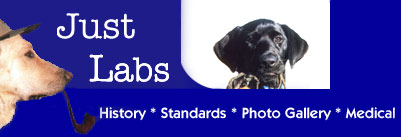
|
|
|
History |
|||||||||||||||
|
|
The Labrador Retriever was developed in England in the mid 1800s by a
handful of private kennels dedicated to developing and refining the
perfect gundog. That many such kennels were pursuing their own vision of
such a dog is the reason behind the variety of today's retriever breeds.
By the turn of the century, these retrievers were appearing in the British Kennel Club's events. At this point, retrievers from the same litter could wind up being registered as different retrievers. The initial category of "Retrievers" included curly coats, flat coats, liver-colored retrievers and the Norfolk retriever (now extinct). As types became fixed, separate breeds were created for each and the Labrador Retriever finally gained its separate registration under the Kennel Club in 1903. While there have been strains of Labradors bred pure up to this time, it is unknown how many of these cross-bred dogs were folded into "Labradors" or into other breeds as the registrations began to separate. Many breeders feel that crossbreeding at this time accounts for much of the poor type that can appear today; however claims about the use of Pointers or Rottweilers can probably be safely discounted. The first two decades in the 20th century saw the formation in Britain of some of the most influential kennels that provided the basis for the breed as we know it today. Lord Knutsford's Munden Labradors, and Lady Howe's Banchory Labradors are among several. At this time, many dogs distinguished themselves in both field trials and conformation shows; the high number of Dual Champions at this time attests to the breed's versatility. Labradors were first imported to the United States during World War I. At this point, the AKC still classified them as "Retrievers;" it was not until the late 1920's that the retrievers were split up into the breeds we know today in the AKC. The Labrador Retriever has been used heavily in the US as a gundog; the American Labrador Retriever Club, Inc. (LRC, Inc), is to this day primarily a field trial organization, and it was instrumental in forming the AKC field trials. The two World Wars greatly diminished the breed in numbers (as it did many others). After the second World War saw the rise of the Labrador Retriever in the United States, where Britain's Sandylands kennel through imports going back to Eng CH Sandyland's Mark influenced the shape and direction the show lines took in this country. Other influential dogs include American Dual CH Shed of Arden, a grandson of English Dual CH Banchory Bolo, especially evident in field trial lines. This return trip to the Americas resulted in the widely expanded use of
the Labrador as a gun dog. In Britain, the Labrador was, and still is,
used primarily for upland game hunting, often organized as a driven bird
shoot. Typically, separate breeds were used for different tasks; and the
Labrador was strictly for marking the fall, tracking and retrieving the
game. But in the United States and Canada, the breed's excellence at
waterfowl work and game finding became apparent and the Labrador soon
proved himself adaptable to the wider and rougher range of hunting
conditions available. The differences between British and American field
trials are particularly illustrative. |
||||||||||||||
| |||||||||||||||